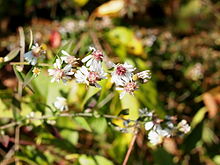Symphyotrichum lateriflorum
From Wikipedia, the free encyclopedia
| Calico aster | |
|---|---|
 | |
| Illustration | |
| Scientific classification | |
| Kingdom: | Plantae |
| (unranked): | Angiosperms |
| (unranked): | Eudicots |
| (unranked): | Asterids |
| Order: | Asterales |
| Family: | Asteraceae |
| Tribe: | Astereae |
| Genus: | Symphyotrichum |
| Species: | S. lateriflorum |
| Binomial name | |
| Symphyotrichum lateriflorum (L.) Á. & D. Löve | |
Symphyotrichum lateriflorum (common name calico aster[1] or starved aster[2]) is a species of flowering plant in the daisy family Asteraceae, native to eastern North America. In the British Isles it is still widely referenced under its old name, Aster lateriflorus syn. A. diffusus, A. vimineus.[3]
Description
Growing to 120 cm (47 in) tall by 30 cm (12 in) wide, S. lateriflorum is a clump-forming herbaceous perennial with alternate, simple leaves on stiff, hairy, purplish stems. Small white or pale lilac composite daisy-like flowers are borne in corymbs up to 15 cm (6 in) across in late summer and fall (autumn).
Cultivation
Like other asters, this plant is valued in gardens for providing late colour after the main flowering season has finished. The cultivars S. lateriflorum var. horizontale[4] and 'Coombe Fishacre'[5] have gained the Royal Horticultural Society's Award of Garden Merit.





No comments:
Post a Comment